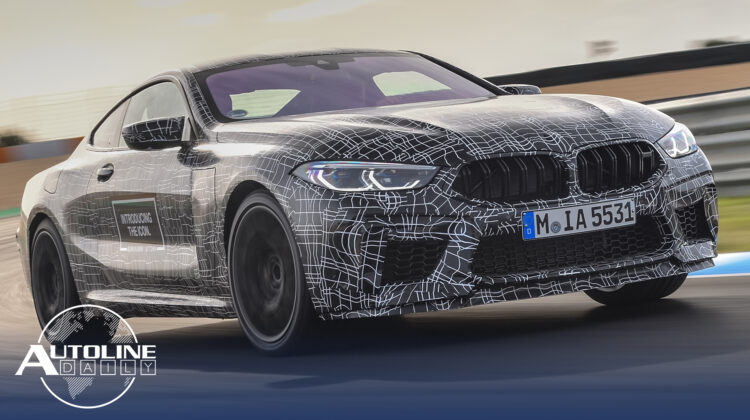
Follow us on social media:
Runtime: 9:46
0:26 Is It Time to Drop the F in FCA?
1:21 VW Plans Low Cost EV
2:27 BMW Shares Some M8 Details
3:28 Daimler & Bosch Launch Ride Hailing Service in CA
4:21 You Said It!
Visit our sponsors to thank them for their support of Autoline Daily: Bridgestone , Dow Automotive Systems , Lear Corporation , and ExxonMobil.
On today’s show…VW is going to make cheap EVs to take on Tesla…the Bay Area is becoming the epicenter for autonomous vehicles…and why it’s time for FCA to drop the F in its name. All that and more coming right up on Autoline Daily.
This is Autoline Daily the voice of the automotive industry.
WHAT THE F?
Is it time to drop the F in FCA? Bloomberg reports that a small investor group is calling for Fiat-Chrysler Automobiles to sell off Fiat to Peugeot, and spin off Maserati and Alfa Romeo. It wants FCA to concentrate on North America, where in the 3rd quarter, the company made 97% of its profits. Here’s our Autoline Insight. While FCA does not break out earnings for Fiat, we’re quite sure it doesn’t make any money. And it will require a lot of investment going forward. So why invest billions in a brand that is never going to provide a return on that capital? And yet, we’re realists too. This is not going to happen as long as the Agnelli family controls 50% of FCA’s shareholder voting rights. Italy would never forgive the Agnelli’s if they sold off Fiat.
VW PLANS LOW COST EV
Volkswagen is planning on introducing a cheap EV to take on Tesla. According to Reuters, it will cost less than 20,000 euros or about $23,000. VW plans to make 200,000 a year. We’re guessing it will have a small battery to cut cost, so look for a range around 80 miles. Another EV, the I.D. Aero, a mid-size sedan, will have a production volume of 100,000 units. Even though VW will sell these cars at an affordable price, we doubt it will make a profit on them. It’s regulations that are forcing automakers to make electrics, not the allure of making a fortune.
Still to come…BMW shares details about the new M8.
BMW SHARES SOME M8 DETAILS
The other day we were talking about the BMW 8 Series Convertible, today we’ve got more info on the performance M8 version. While the facts are still vague, the M-division was able to cut weight, increase rigidity and bolt in a unique suspension system. Power comes from a twin-turbo V8 that produces north of 600-horsepower. It gets mated to an all-wheel drive system with rear-wheel bias, but there will also be a 2-wheel drive mode. And here’s something that caught our eye. There’s no direct mention of the M8 being electrified, but the press release talks about “electric power consumption figures,” which leads us to believe there will be a plug-in hybrid version. Remember, many European cities are talking about banning cars running on an internal combustion engine. But plug-ins can run on electric power in city centers, so it makes sense to make it a plug-in. The M8 launches in 2019, so it won’t be long before we know more.
DAIMLER & BOSCH LAUNCH RIDE HAILING SERVICE IN CA
Daimler and Bosch announced plans to test an autonomous ride hailing service in San Jose, California. It will launch in the second half of 2019 for a number of select users. They’ll use Mercedes S-Class’s equipped with Level 4/5 autonomous technology. The Bay Area is quickly becoming the center of the universe for autonomy. Waymo, Lyft, and GM to name a few are all performing tests, as well as dozens of other startups and suppliers.
Coming up next, it’s time for You Said It!.
YOU SAID IT!
And now it’s time for some of your feedback.
BobD Says: “On your comment of giving GM and Ford credit for posting their revenue and losses on their mobility activities, it is not “gutsy” but rather a requirement to disclose these numbers since they are public companies.”
Bob, that’s not the case. They don’t have to break out these numbers. That’s why we’ve never seen a profit and loss statement for OnStar. Public corporations do have to provide shareholders with transparency on how the company is performing. But they don’t have to break out everything.
Stuart Says: “Why is the government even involved with fuel economy? There’s no shortage, and doesn’t look like there will be for hundreds of years. Modern cars emit practically zero emissions. Could it be that government just wants to control everyone and everything?”
Stuart, my guess is you’re not old enough to remember how bad air pollution was half a century ago. Or remember how much lead there was in gasoline back then. The free market and competition is a great way to improve products and services. But in some areas, like automotive emissions and safety, we can’t wait around for market forces to stop making people sick or even killing them. We need regulations to do that.
We’ve got a couple of questions about China. WineGeek Says: “Now that the rapidly growing Chinese market is not growing so fast, what do they do now?”
And phred wants to know: “The Chinese manufacturing landscape appears to be full of sinkholes and landmines that favor the local subsidized companies. How will this arrangement be able to penetrate the USA market?”
The world better watch out. As sales slow in China, Chinese companies will look for other global markets to absorb their excess capacity, i.e., they’re going to go on an export binge. But they won’t be coming to the USA, at least not anytime soon. With Trump’s 25% import tax on Chinese made vehicles they have no chance to compete in the American market.
Brian Murray wants to know: “Was it really smart for Jaguar to invest millions/billions in three new production facilities that are outfitted for ICE vehicles?”
Look, we’re not at the end of the ICE age, at least not yet. Even the most bullish proponents of electrified cars admit that 70% of all vehicles in 2030 will have a piston engine on board. That’s nearly 3 design cycles away, so Jag will have plenty of time to revamp those plants if EVs really catch on.
3xyScorp heard our report that GM skipped going all aluminum with its pickups in favor of using many different types of materials to cut cost. “If GM using steel has such a price advantage, why are their trucks so FNG Expensive…even the mid-size CC!?”
Cost is one thing. Price is another. GM is pricing its trucks to maximize profits. As long as people are lining up to buy them then it got the price right.
David Lopez want to know: “Will having so many different metals increase repair costs and make it harder to recycle at the end of life?”
David, you’d be amazed at how easy it is to recycle all the metal in a car or truck. Plastics, not so much. Glass, not at all. But high volume recycling yards can recycle 800 vehicles a day, close to the number of cars that an assembly plant makes. And they fill up semi-trucks with scrap steel, aluminum, magnesium, copper and zinc because there is so much market demand for that scrap.
Temper44 has a question.: “Why did Elon Musk say that the Tesla pickup truck would be made out of titanium? Is Elon Musk forced to use titanium to save weight, so he can fit bigger batteries into the truck?”
Temper, the dude was smoking a doob. He’s not going to make a truck out of titanium. A ton of advanced high strength steel is about $1,000. Titanium is about $60,000 a ton. You do the math. It ain’t gonna happen.
And finally John Viggiani says: ”Just getting into referring to the Autoline Network channel for current car industry news. I like the variety of items that receive a brief focus and that I can look further into topics of personal interest afterwards.”
John, thanks for that feedback, you just made our day. And with that we’re going to call it a day. Thanks for watching and don’t forget, we’ll be right back here on Monday.
Thanks to our partner for embedding Autoline Daily on its website: WardsAuto.com

John McElroy is an influential thought leader in the automotive industry. He is a journalist, lecturer, commentator and entrepreneur. He created “Autoline Daily,” the first industry webcast of industry news and analysis.





